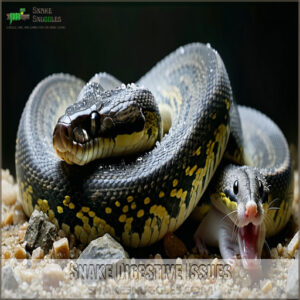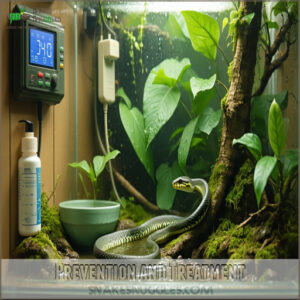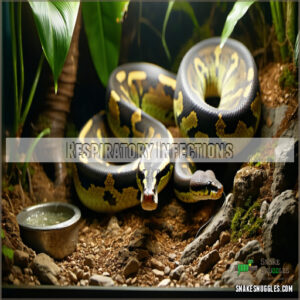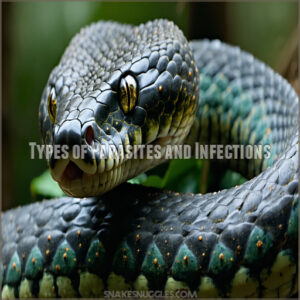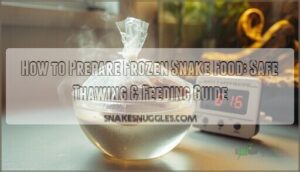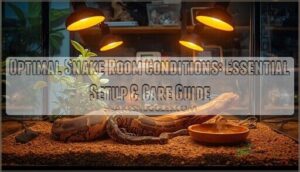This site is supported by our readers. We may earn a commission, at no cost to you, if you purchase through links.
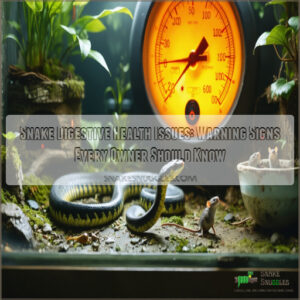
Just like humans need the right environment to eat comfortably, your serpentine friend needs proper temperatures and hiding spots to maintain healthy digestion.
Watch for signs like feeding refusal, regurgitation, or constipation – they’re your snake’s way of saying something’s off.
Temperature regulation is key: without the right warmth, your snake’s metabolism slows down faster than a turtle in winter.
From choosing the right prey size to maintaining ideal humidity levels, creating the perfect dining experience for your scaly companion makes all the difference.
Understanding these basics helps prevent more serious complications.
Table Of Contents
- Key Takeaways
- Snake Digestive Issues
- Common Digestive Problems
- Respiratory Infections
- Parasites and Infections
- Preventing Digestive Health Issues
- Frequently Asked Questions (FAQs)
- What problems does a pet snake have?
- What are the signs of illness in snakes?
- Do snakes have respiratory problems?
- Do snakes have health problems?
- Why does my snake have poor digestion?
- What diseases does a pet snake have?
- What are the symptoms of snake disease?
- How do I know if my snake is impacted?
- What are the health issues with ball pythons?
- How is a snake’s digestive system different from a human’s?
- Conclusion
Key Takeaways
- Keep your snake’s enclosure at the right temperature and humidity to ensure proper digestion and prevent health problems.
- Choose appropriately sized prey for easy swallowing and digestion, and avoid handling your snake after feeding.
- Watch for warning signs like appetite loss, regurgitation, bloating, or constipation, and act quickly if anything seems off.
- Maintain a clean environment, and schedule regular check-ups with a reptile vet to catch issues early.
Snake Digestive Issues
If your snake refuses to eat or shows signs like regurgitation or bloating, it’s a clear red flag for digestive issues.
Paying attention to their feeding habits, prey size, and enclosure temperature can help you prevent serious health problems.
Failure to Feed
Struggling with your snake’s appetite loss?
Feeding refusal often stems from issues like low enclosure temps, lack of hide spots, or food aversion.
Stress from over-handling or a hunger strike in wild-caught snakes isn’t uncommon.
Fix feeding issues by ensuring warmth, offering suitable food, and creating a stress-free environment.
Making them feel cozy often solves the refusal to eat!
Understanding proper feeding techniques is essential to address these problems, including feeding refusal.
Owner Error and Feeding Problems
Feeding your snake wrong can mess up its health big time.
Skipping proper feeding schedules or offering low-quality food leads to underweight snakes, malnutrition, or even snake regurgitation issues.
Overfeeding? That’s a ticket to snake constipation relief struggles or impaction nightmares.
Stick to digestible prey sizes, avoid handling after meals, and consider digestive health supplements if your snake’s struggling to keep food down.
Environmental Temperature and Feeding Response
A snake’s feeding response depends heavily on environmental temperature.
Proper thermoregulation boosts digestion, while low temperatures slow metabolism.
Use temperature gradients to create ideal zones for processing meals.
Thermal regulation also impacts feeding intervals, so watch for cues like sluggishness or lack of appetite.
Internal parasites can impact snake health, so understand common reptile parasites.
Pair this with balanced humidity levels to keep snake digestive health issues at bay.
Snake Preferences and Feeding Techniques
Understanding feeding cues can save you from common snake feeding problems.
Every snake has its quirks—some prefer live prey items, while others thrive on thawed rodents.
Stick to proper prey size for snake nutrition and digestion, and adjust feeding schedules to match their activity.
A wrong feeding technique or lack of food variety may harm snake digestive health long-term.
Recognizing digestive health issues is essential for maintaining a healthy snake and understanding feeding cues.
Common Digestive Problems
Digestive problems like regurgitation, constipation, and impaction are surprisingly common in snakes and can often be traced back to improper feeding or housing conditions.
It’s essential to recognize these issues early, as they can quickly lead to serious health risks if left untreated, which makes early recognition crucial for preventing digestive problems.
Regurgitation and Constipation
Handling too soon after feeding? That’s a big no-no—it’s a common culprit of snake regurgitation issues.
Cold enclosures and parasites also mess with gut motility, leaving you with regurgitated meals or snake constipation relief to sort out.
Watch for signs like poor stool quality or lack of appetite.
Check food temperature and don’t skip hydration; small adjustments prevent bigger digestive problems, which can be considered a big no-no and affect gut motility.
Impaction and Obstructions
If your snake looks bloated or struggles to pass waste, it could be food impaction or a gut obstruction.
Intestinal blockages often happen when prey is too large or the snake ingests substrate like wood chips.
Bowel issues like this can lead to serious problems.
Offer snake constipation relief with warm water soaks or seek snake impaction treatment from a vet.
Signs of Digestive Issues
When your snake skips meals or suddenly loses weight, it’s waving a red flag.
Watch for digestive warning signs like changes in stool quality, bloating, or even bouts of constipation.
Signs of serious digestive problems, including intestinal blockage or impaction, might also show up as lethargy.
Appetite loss paired with strange behavior could mean it’s time for a vet visit.
Prevention and Treatment
Now that you’ve spotted the warning signs, let’s talk about keeping your scaly friend healthy.
To prevent digestive disorders, maintain proper temperatures using digital thermometers and guarantee a balanced diet.
Keep their home clean and spacious enough for stretching out.
If issues arise, your vet might recommend reptile digestive enzymes, probiotics, or specific therapy options.
Regular check-ups help catch intestinal blockages early, saving you both stress later.
Monitoring for digestive health issues is vital to identify potential problems before they become severe.
Respiratory Infections
You’ll notice your snake’s digestive system slowing down when those pesky respiratory infections strike, often showing up as wheezing or excess mucus around the mouth and nostrils.
While you might think a snake’s cold is just a minor issue, respiratory problems can quickly turn serious if you don’t maintain the right temperature in your snake’s home.
So keeping an eye on these symptoms is essential for your scaly friend’s health, and it’s crucial to be aware that respiratory infections can have severe consequences.
Impact on Digestion
A respiratory infection can throw your snake’s entire digestive system off balance.
When your scaly friend battles these infections, their metabolic rate drops, making it harder for them to process food properly.
Here’s what’s happening inside:
- Their body’s struggling to maintain the right temperature for digestion
- Digestive enzymes aren’t working at full strength
- Nutrient absorption takes a hit from reduced oxygen levels
- Food quality matters even more during recovery
- Gut health becomes extra sensitive to environmental changes
Watch out – if your snake’s breathing seems off, their digestive system might be suffering too.
Proper reptile digestive enzymes and gut health management become critical when respiratory issues arise, and it’s essential to consider food quality and nutrient absorption to support your snake’s recovery.
Symptoms and Signs
Your snake’s health can tell a story through noticeable signs.
If you hear wheezing or weird gurgling sounds coming from your pet, pay attention. Watch for mucus around the mouth, open-mouth breathing, and nasal discharge – these Warning Signs aren’t just random Health Indicators, they’re your snake’s way of waving a red flag that something’s wrong with their breathing.
Respiratory infections often exhibit these distressing respiratory symptoms, which can be a clear indication of an underlying issue, making respiratory infections a critical concern for snake owners.
Causes and Prevention
When poor husbandry hits your snake’s immune system, respiratory infections aren’t far behind.
Your scaly friend’s well-being depends on creating the perfect environment.
- Keep humidity and temperature at ideal levels – like a cozy day in the tropics
- Guarantee proper ventilation to prevent stagnant air buildup
- Maintain spotless enclosure hygiene to ward off bacterial growth
- Reduce stress by providing adequate space and minimal handling during vulnerable times
This environment is crucial for preventing respiratory infections and ensuring the overall health of your snake, which relies on proper ventilation and spotless enclosure hygiene.
Treatment and Recovery
Once diagnosed, you’ll need to team up with a vet on a treatment plan that includes antibiotics and supportive care.
The road to recovery typically involves bumping up your enclosure’s temperature, managing humidity levels, and keeping up with fluid therapy.
Most snakes perk up within a few weeks of consistent care—but don’t skip those meds even if your scaly friend seems better!
Parasites and Infections
You’ll want to watch out for those sneaky parasites in your snake’s digestive system, as they can cause serious health issues like weight loss and diarrhea if left unchecked.
While these unwanted guests might be trying to crash your snake’s gut party, you can keep them away with a clean enclosure and proper feeding habits, which are crucial for preventing the growth of these parasites and maintaining your snake’s overall health, including preventing issues like weight loss.
Types of Parasites and Infections
Regarding digestive troubles, your snake might be battling several unwanted guests.
Mite infestations show up as tiny black dots, while bacterial infections often start with mouth rot before affecting digestion.
You’ll spot fungal diseases in humid conditions, and protozoan parasites mess with feeding patterns.
Watch for intestinal parasites through undigested food in droppings, and don’t ignore signs of restless behavior or frequent soaking.
Importance of Clean Enclosure and Balanced Diet
Keeping your enclosure spotlessly clean isn’t just about looks – it’s your first defense against unwanted parasites.
You’ll want to disinfect the substrate and décor weekly while maintaining proper temperature and humidity levels.
Regular use of a snake enclosure cleaner is essential for a healthy environment.
Just like a balanced diet keeps you healthy, offering quality, appropriate food helps your snake ward off infections.
Remember: a clean habitat and proper nutrition are your dynamic duo for preventing digestive health issues.
Preventing Digestive Health Issues
You’ll be relieved to know that preventing digestive problems in your snake isn’t rocket science – it’s all about maintaining the right temperature, offering proper meals, and keeping their home clean.
Just like you’d want a comfy house and good food for peak health, your snake needs these basics plus regular vet check-ups to catch any issues before they turn into real troublemakers.
Your snake needs these basics for peak health, which includes a clean environment and proper care.
Proper Housing and Temperature Gradient
Maintaining the right temperature gradient in your snake’s enclosure isn’t rocket science, but it makes all the difference.
You’ll want housing design that offers both warm and cool spots – think of it like a temperature buffet where your snake can choose what feels right.
Set up thermal gradients between 75-95°F depending on species, and keep ventilation systems working to prevent stagnant air and unwanted humidity levels.
Proper snake enclosures require careful planning and consideration of snake enclosure designs to guarantee the health and well-being of your pet, which is crucial for creating an ideal environment.
Balanced Diet and Hydration
With proper heating and housing sorted, let’s talk about keeping your snake well-fed and hydrated.
You’ll want to focus on nutrient balance and proper hydration to prevent snake digestive issues.
Snakes benefit from a balanced reptile diet with varied protein sources.
- Offer whole prey animals for complete nutritional value – they’re nature’s perfect snake meal package
- Keep fresh, clean water available 24/7
- Follow a consistent feeding schedule based on your snake’s age and size
Remember: watching your snake’s feeding response and shedding patterns tells you if you’re on the right track with their reptile nutrition.
Regular Veterinary Check-ups
You’ll need to schedule snake health visits at least once a year.
Regular check-ups with a reptile veterinarian are essential since they’ll track your snake’s weight, perform key diagnostic tests, and create detailed medical records.
Young snakes may need more frequent visits, while annual check-ups work well for adults.
Think of these visits as your snake’s yearly wellness roadmap – they’re your best shot at catching digestive health issues early, which is crucial for maintaining your snake’s overall health.
Monitoring Behavior and Addressing Issues Early
Your snake’s daily behaviors paint a clear picture of their digestive health.
While regular vet visits set a baseline, you’re perfectly positioned to spot changes between check-ups.
Think of yourself as a health detective – those small changes in your snake’s routine often tell the biggest stories.
- Your snake’s post-meal posture reveals comfort levels – relaxed coils suggest smooth digestion
- Active exploration during peak hours indicates a healthy appetite and good gut function
- Regular, consistent droppings point to a well-functioning digestive system
- Unusual body positions might signal digestive discomfort or constipation
- Changes in feeding enthusiasm can be early warning signs of digestive issues
Regular monitoring of these behaviors can help you identify potential problems early on, allowing for timely intervention and preventing serious health issues.
By being attentive to your snake’s daily activities and routine behaviors, you can gain valuable insights into their overall health and well-being.
It is crucial to maintain a baseline understanding of your snake’s normal behavior to effectively spot any deviations that may indicate a health problem.
Frequently Asked Questions (FAQs)
What problems does a pet snake have?
Your pet can face respiratory infections, scale rot, mouth rot, parasites, and digestive problems.
They’ll show signs through irregular eating, abnormal shedding, or unusual behavior.
Watch for these warning signals carefully.
What are the signs of illness in snakes?
Just like checking your car’s dashboard for warning lights, monitoring your snake’s health means watching for symptoms.
Look for lethargy, loss of appetite, wheezing, scale abnormalities, regurgitation, and unusual waste output, which are all key indicators of your snake’s overall health, including lethargy.
Do snakes have respiratory problems?
Yes, you’ll see respiratory issues like wheezing, open-mouth breathing, or bubbles from nostrils in your scaly friend.
Watch for unusual sounds during breathing – it’s a common health concern that needs vet attention.
Do snakes have health problems?
Just as a warrior faces battles, your serpentine friend can encounter various health challenges.
You’ll need to watch for common issues like respiratory infections, digestive problems, and skin conditions that affect their well-being.
Why does my snake have poor digestion?
Your snake’s digestion troubles could stem from incorrect temperature, stress, feeding schedule issues, parasites, or improper prey size. Regular vet check-ups and maintaining ideal habitat conditions help prevent digestive problems.
What diseases does a pet snake have?
Nearly 60% of pet snake health issues stem from poor husbandry.
You’ll need to watch for respiratory infections, parasites, bacterial infections like mouth rot, fungal problems, and nutritional deficiencies in your scaly friend, which can be caused by poor husbandry.
What are the symptoms of snake disease?
Look out for lethargy, loss of appetite, abnormal shedding, mouth rot, respiratory issues like wheezing, and unusual discharge.
You’ll also notice behavioral changes, swelling, or discolored scales when your pet’s unwell.
How do I know if my snake is impacted?
A bloated midsection and no droppings for several weeks means trouble. You’ll spot your pet refusing meals, moving sluggishly, and showing clear belly swelling that needs immediate vet attention.
What are the health issues with ball pythons?
Your ball python might face respiratory infections, scale rot, mouth rot, thermal burns, parasites, or dehydration.
You’ll need to watch for symptoms like wheezing, discolored scales, irregular shedding, and changes in eating patterns, which can indicate serious health issues.
How is a snake’s digestive system different from a human’s?
A snake’s digestive system, designed for swallowing prey whole, is all about efficiency.
Unlike humans, snakes can digest bones and fur.
Their metabolism slows drastically between meals, sometimes lasting weeks or months without eating.
Fascinating, right?
Conclusion
Did you know that around 80% of snake digestive health issues stem from incorrect husbandry?
By keeping temperatures steady, providing proper humidity, and ensuring a clean, stress-free habitat, you’re setting your snake up for success.
Watch for red flags like regurgitation, lack of appetite, or constipation, and remember that small changes, like adjusting prey size or checking your heat source, can make a big difference.
Your snake’s smooth digestion starts with your care and attention.
- https://pmc.ncbi.nlm.nih.gov/articles/PMC6206181/
- https://www.myfamilyvets.co.uk/snake-health-problems
- https://veteriankey.com/diseases-of-the-digestive-system-4/
- https://www.pangeareptile.com/collections/uvb-bulbs-florescent-mercury-vapor
- https://www.healthline.com/nutrition/7-common-nutrient-deficiencies

